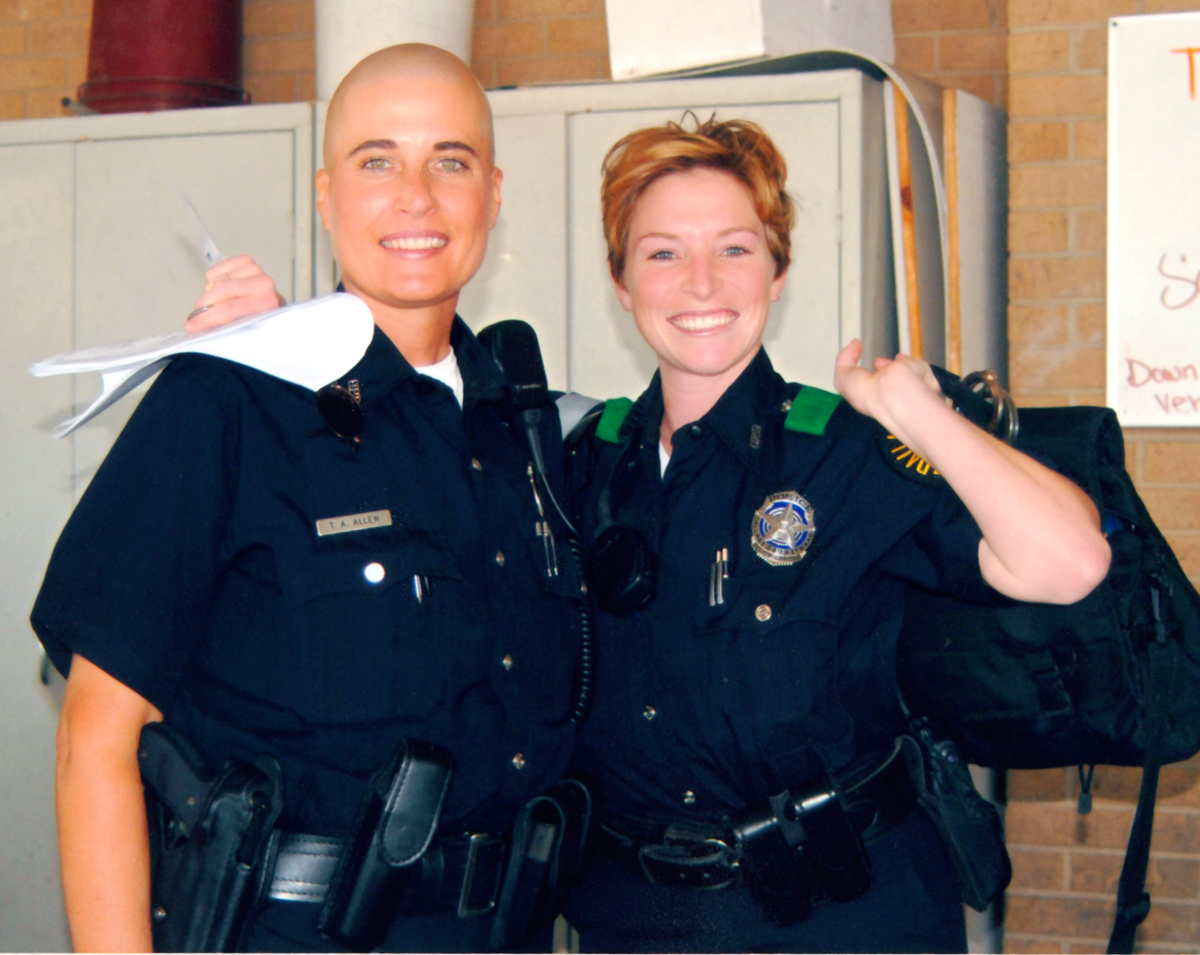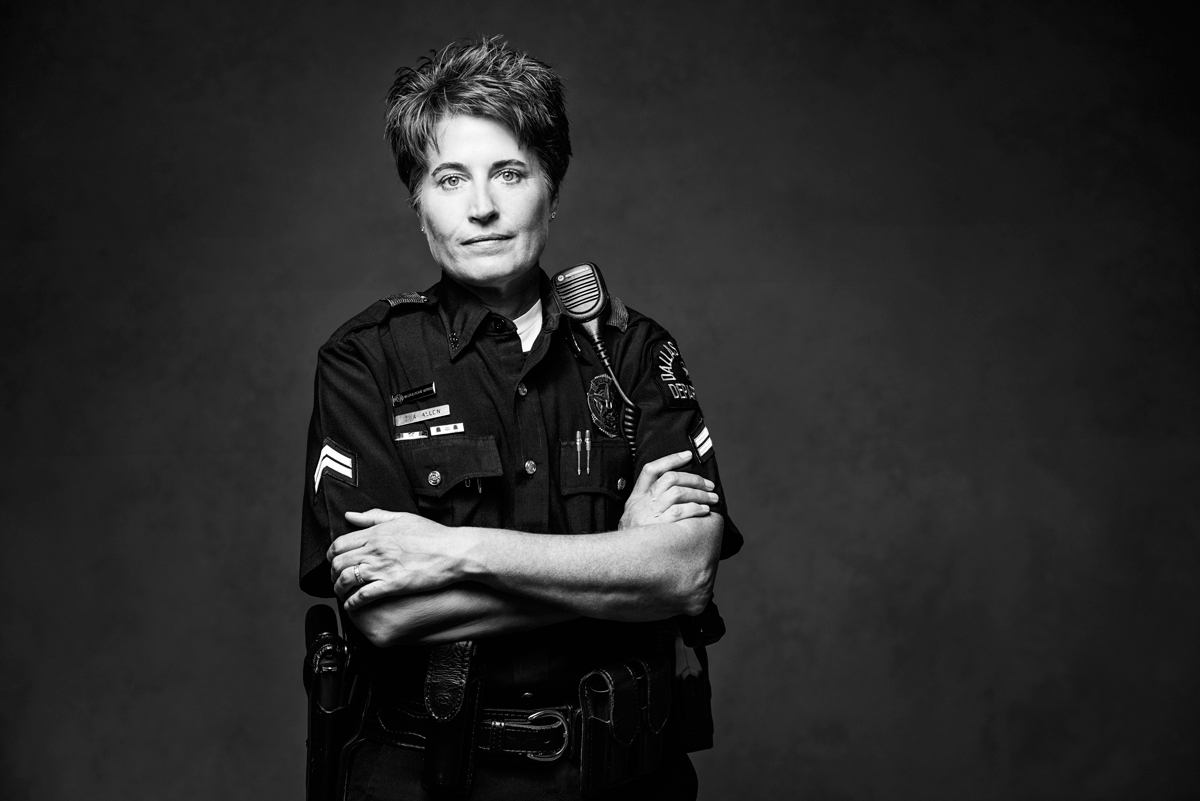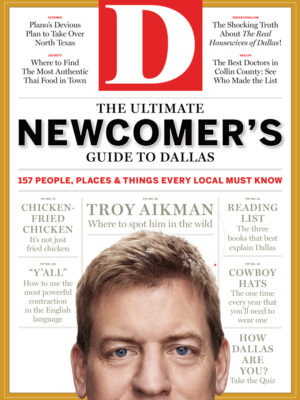Trish Allen has two jobs and a death sentence.
Twice a week, she works security from midnight to 6 in the emergency room at Doctors Hospital, in East Dallas. Through the wee small hours of the other five nights, she cruises the city’s meanest streets in a beat-up car, looking for trouble. Allen works in plainclothes for the Dallas Police Department.

When I first met her, at the Four Seasons in Las Colinas, she sized me up and, apropos of nothing, said with a smile, “I can put you on the floor right now.” She has green eyes that do not look away, an athlete’s graceful way of moving, and so much charisma that she could bottle it. At 46 years old, she looks healthy. We sat for a chat with Sandra Haynie, the self-effacing member of the World Golf Hall of Fame and Allen’s mentor. Of all things, Allen was a professional golfer before she became a cop. We talk about another figure from golf’s Mount Rushmore, Ben Hogan, because the stoic, icy Hogan mentored her as well. Haynie and Hogan? That’s like Florence in 1500, and da Vinci and Michelangelo coaching an apprentice painter. Who the hell is this woman? I wondered.
•••
The five allen kids of Vallejo, California, were taught to box—if not to fight—by their in-your-face Portuguese grandpa. Their father, Skip, was an electrician and worked on the nuclear submarines docked at the nearby Mare Island Naval Shipyard. Their mother, Thelma, was domineering.
“Thelma was a lot like our father,” says Cathey Vallerga, a maternal aunt of Allen’s and a horsewoman who is still winning trophies for barrel racing at age 66. “She could act very disappointed if Trish didn’t do well in a tournament.”
“I remember her as a tomboy and a daredevil, riding a unicycle around,” says Allen’s older sister, Erin Ackerman. “She’s very outgoing and outspoken. She don’t take crap from nobody.”
“I never said anything, but I was really proud when she was the only girl on the golf team,” says Erin Ackerman, Trish’s older sister by two years. The Vallejo High Apaches didn’t have a girls’ team. “Trish and I fought like normal sisters, I guess. I remember her as a tomboy and a daredevil, riding a unicycle around. She’s very outgoing and outspoken, just like our mom. She don’t take crap from nobody.”
Kristi Coggins won the competition for Allen’s services as a college golfer. “A very calm personality, very steady,” says the former TCU women’s golf coach. “When you put a bunch of girls together—I don’t want to call it drama—but every team needs someone like Trish. But she was always fighting her own body. I remember having to take her to the ER in Tucson when she hyperextended her thumb just picking up her golf bag.”
Another time, Allen teed it up in the biggest event in college golf, the NCAA championships, just four days after an appendectomy. Tough as a truck-stop steak, that Allen—which Hogan admired.
The reclusive, granitic Hogan had a soft spot for the TCU women’s golf team. On the Mondays the TCU team practiced at Shady Oaks, Hogan’s club in Fort Worth, the frequent U.S. Open champion would drain his martini and come out of his aerie to watch them finish. He was a hugger.
“He always told us that right-handed golfers should carry their golf bags on the left shoulder, to strengthen it,” Allen says. “But we’d be sure not to do it when we got within sight of the clubhouse, just so he’d come out to remind us and talk with us.”
When the Navy base in Vallejo closed, costing her father his job, Allen told coach Coggins she would have to withdraw from school and return to California, because she had only a half-scholarship and couldn’t afford the other half on her own. Hogan promptly established an endowment whose first beneficiary would be the hardworking girl from Vallejo.
Allen had risen to 22nd in the national ranking of Division 1 women amateur golfers when she began to play for pay. For three years, Allen toiled in the high minors on something called the Futures Tour. To make ends meet, she worked in the pro shop at Brook Hollow Golf Club, in Dallas, when her schedule permitted. She came tantalizingly close to qualifying for the big league, the LPGA Tour, but no cigar. Disappointing Haynie was the worst part, Allen says.
“She didn’t disappoint me at all,” Haynie says. “I’m proud of her accomplishments outside of golf, of her mental strength and commitment. She was given another chance, and she is going to embrace it.”
A cop at a party suggested Allen consider police work. Of the 41 applicants in her class in the smoking-hot summer of 2004, only 21 made it through. She is one of six survivors out of 41 in that drug trial. She missed reaching the finals of the LPGA qualifying tournament by two shots. Life can be a numbers game.
Eighteen months into her new career, her number came up.
•••
A 3 am body scan revealed a broken neck. But it also found something else: tumors, lots of them, in her pelvis and neck. The cancer would have killed her within six months if not for the lucky car crash.
The peek at Nirvana required an intricate arrangement of coincidence and circumstance. On a hot October afternoon in 2006, a few minutes before the 3 pm shift change, Allen was getting ready to work the third watch. She’d be riding alone that afternoon and evening, because her partner at the time, Corporal Jana Shackelford, would be busy showing the ropes to a rookie. Allen signed out car No. 5024, a blue and white six-cylinder 2005 Chevy Impala like all the others at DPD’s Southwest station, and gassed it up at pump No. 2, because she always took that car and always used that pump. Ritualized.
Just as Allen clanked the nozzle into its cradle, a frantic voice on the radio shouted, “Shots fired, officer assist, Broken Bow Apartments, I need help, quick!” The Broken Bow was notorious for drugs, prostitution, and shootings.
Allen jumped in the car and responded, “Triple 4 en route.” Her adrenaline spiked, and she liked it.
Right on Westmoreland, fast, then right on Kiest, very fast, Allen remembering that at 60 mph, a police car outdrives its siren. A school zone—where even hot-pursuit police must slow to 20—only amped up the urgency to help a fellow officer deal with a bad man with a smoking gun screaming for his ex to open the goddamn door. But about 200 yards from the apartment complex, a woman in a white Grand Am panicked at the sound and sight of the DPD in her rear view, and nonsensically aborted the left turn she was making in favor of pulling back out into the center of Conway Street. Officer Allen swerved hard right and stood on the brake.

When she returned to this dimension, she felt excruciating pain and smelled burning flesh. “Am I on fire?” she asked. The thump on her head apparently caused the interesting but false olfactory moment; she wasn’t burning. Consciousness drifted away again, and she awoke on a table in the Methodist Dallas Medical Center emergency room, naked, concussed, and sightless, listening to the beep-beep-beep of her heart monitor and in great fear of aspirating her own vomit. Her stomach abruptly emptied, as she expected—as did her bladder and bowels, which she did not expect—but Allen did not drown.
A 3 am body scan revealed the broken neck. But it also found something else: tumors, lots of them, in her pelvis and neck. The cancer would have killed her within six months if not for the lucky car crash.
The soul-sapping ordeal of treatment began at St. Paul Hospital. The first step was swallowing radioactive iodine-131 pills, which would kill the tumors from within. A nurse carrying a tightly sealed metal box led Allen to a tiny room. The nurse left, and Allen opened the box, retrieving the four big, jet-black pills within. Within a few hours, she’d be as radioactive as a uranium mine, so no visitors for four days.
“Wait!” a hospital staffer ordered. “We don’t have a room ready for you yet.” “Too late,” Allen replied. “I already took the pills.” With no time or energy for a debate, another cop sped her home in his squad car, siren whining, red and blue roof lights rotating and flashing. Lieutenant Teena Schultz rushed over to remove Allen’s guns, ammo, and computer, to save them from being contaminated by the gamma rays that would soon be emitted by their owner.
No one in Allen’s army of friends could stay with her, of course, so from time to time they pitched bags of food and notes of support onto the second-floor balcony of her apartment. Not that radioactive girl could always summon the strength to get them. The pills were not supposed to make her sick, but did they ever. After one or two failures to reach the bathroom from her bed, she “Girl Scouted,” as she puts it, a solution. She filled the bathtub and crawled in, which felt like heaven on her shivering body, and when the nausea came, she simply threw up in the water. Drain, rinse, and repeat.
Step two, after the radiation-ablation: chemo, starring a drug called Herceptin, which Allen called “Big Red.” Steps three and four were separate surgeries on her neck and pelvis. Encouraged and inspired by her oldest brother, Mike Hedrick, an Annapolis grad and Navy man, Allen returned to work in February 2007, only four months after the crash and cancer diagnosis.
“I worked my ass off in rehab, all day, every day,” Allen says.
She looked, well, interesting: as hairless as an egg and as thin and white as a cigarette. And those eyebrows! While talking to an old friend who worked in the production department at Disney, Allen had mentioned how weird it felt to be so depilated, without so much as an arm hair. So the friend got the prop department to send a couple sets of glue-ons, guessing at the proper shade of brown by looking at old photographs.
One night soon after her return to the job, Allen and Shackelford endeavored to pull over a stolen car. The large male driver hopped out and ran. Allen chased. One block, two, three—the man chose poorly when he turned into an alley that happened to be crossed by an 8-foot-tall wooden fence. “Before he could get to the top, I pulled him down and hooked him up,” Allen says. “Then I walked around him like a proud animal that had brought down its prey.”
When Shackelford arrived and they stood him up, the car thief stared at the pale dynamo with the eyebrows. “Oh, my God,” he said. “I can’t believe I got caught by a bald white chick.”
The car thief stared at the pale dynamo. “Oh, my God,” he said. “I can’t believe I got caught by a bald white chick.” A bald white chick who still had cancer; Allen’s next scans would show ominously active cells.
There had to be something, some Hail Mary to try. And there was. Friends scoured the internet, worked the phones, and eventually traced a promising path from Johns Hopkins in Baltimore to Switzerland to Cedars Sinai Hospital in Los Angeles. In the safety and efficacy study that started in 2007, half the patients got three drugs and half got four, including combretastatin A-4 phosphate—CA4P—which is designed to damage the blood vessels in the tumors.
Allen lived to fight another day.
•••

She points out the sights: “Dope house. Meth hotel. Best barbecue in Dallas. Got in the middle of a gang shootout at 2 am on that corner. That’s a drug deal. Caught a hit-and-run driver in that parking lot. My worst fight was with some guy on PCP who just kicked my ass.” The streets and the stories frighten me, save for the restaurant reviews.
“The chances of the cancer returning are very good,” Allen says. “But I made a promise to my [late] mother that it would not define me. Sure, some days I wanted to wave the white flag, but I’m so driven. I wouldn’t let it win. I’ve had lots of support from my Texas family and my brothers and sisters in blue.
“So I’ll fight until I can’t. Until then, I’ll squeeze everything out of every day.”
No one seizes the day like Trish Allen. Follow her, if you can, to a Starbucks drive-through, because she always buys for the car behind her. She uses the money from her moonlighting security job to take a nice older lady on vacation. That’s her Texas mom, Maura Hanley, whom she met while working at Medical City Dallas Hospital years earlier. When she gets home from work at dawn, she’s too busy to have regular sleeping hours. Workouts, work, friendships, and relationships must be done perfectly, and with the utmost focus and enthusiasm, because who knows if today is the last chance to get things right?
But Allen’s gung-ho approach to job and sports and survival masks a profound sweetness and an almost childlike sincerity. “I want my life to be a lesson,” she says. “I’d like people to be stronger in the face of sickness, divorce, and death. If I can give one person hope, it will be worth it, just one little piece of hope in your pocket.”
She has a lot to do before she sees the smiling fish again.
Allen founded White Light Charities and Kid’s Circle, both of which primarily benefit cancer survivors. Her inaugural fundraising golf tournament will be held in October. HarperCollins will publish Curt Sampson’s 15th book, Furious George, the autobiography of NBA coach George Karl, in January.






